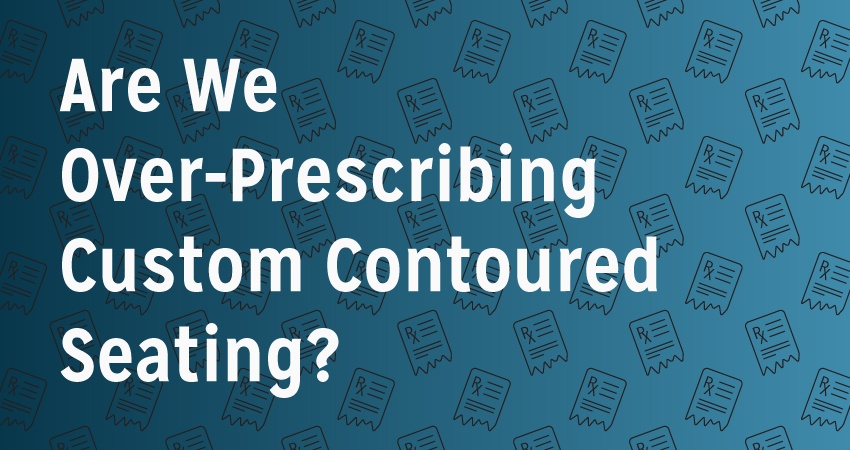
I have been a practicing therapist in the field of Seating & Wheeled Mobility for 33 years. In the last decade I have seen a dramatic increase in the use of custom contoured seating (CCS), at least in the geographical region where I currently practice. Without a doubt, this increase is a direct result of the development of a plethora of quality product options. And many individuals who have been provided these systems have experienced superior outcomes. However, within our specialty clinic we—myself included—have begun to wonder if we are “over prescribing” custom contour.
We all know and appreciate that CCS has many benefits and indications, and for many individuals with significant non-reducible scoliosis and lower extremity contractures it is clearly the only appropriate intervention.
However, there are some big negatives:
-
It is usually the most expensive solution.
-
It is difficult to change or modify in any significant manner.
I have noticed myself recommending custom contour for individuals for whom I would’ve, in the past, recommended either an off-the-shelf solution with after-market modifications or a custom specified “linear” system-perhaps one with different areas of foam thickness to influence shape but with adjustable lateral trunk supports.
Are these people being better served with a custom contoured system?
Most probably are, but I know some are not, or rather, they could’ve been equally well served with a less expensive product. I have worked with several clients who feel they have been “harmed” by an ill-fitting custom contoured system.
When the system cannot be adequately adjusted to meet their changing body, they face drawbacks such as:
-
Pain
-
Increased postural asymmetry
-
And/or skin breakdown
So, why was I increasingly recommending custom contour in situations where I would not have done so in the past? I think three reasons:
First, we DO have better product options for custom contour than we have had in the past, which is a great benefit, and some of these can be modified at least minimally to address changing needs.
Secondly, and on the more negative side, I think we have become a victim of the time pressures within an industry increasingly challenged with reducing reimbursements and revenue. We are pushed to make more sales, and that means finishing the wheelchair assessment and getting an order started. While providing a custom contoured solution requires additional labor time after the assessment, it reduces assessment time up front. Therefore, we may be quick to jump to this solution during the assessment. Let me share a few examples to illustrate the time constraint challenges.
-
Let’s say you are evaluating someone who is in that “grey area”. There are some indications for custom contour, but you are not quite sure it is needed, and for this person there may be some risks of doing custom contour. As the end of an assessment session is approaching and your next client is waiting, it is a lot easier to simply recommend custom contour – because then you’re done!
-
Alternatively, applying good problem solving techniques to carefully consider other less costly and more adjustable options (product trials of off-the-shelf products, seating simulation, etc.) will take more time and likely an additional session.
-
As another example, a linear biangular I-back with offset lateral trunk supports requires complex measurements and may require an additional session just to ensure accuracy and that all the many components and hardware needed are accurately specified.
The third variable I believe influences the tendency to recommend custom contour is the lack of new product development to address the needs of those “grey area” clients: people who have mild to moderate asymmetry that don’t quite fit into off-the-shelf systems.
At our clinic, having recognized this inclination to jump to the “easier” custom contoured solution, we are re-emphasizing our commitment to the benefits of a comprehensive assessment process – spending more time up front to optimize outcomes and reduce the costs of errors post-delivery. This means making the hard choice at the end of an evaluation to recommend additional sessions if needed, to allow adequate problem solving and product trials. If this comprehensive approach to assessment results in a recommendation for a custom contoured product solution, we will not only have better justification for the more costly product, but we will have chosen the best CCS product for this client, and will be better prepared for a successful shape capture.

Kelly Waugh, PT, MAPT, ATP
Kelly Waugh, PT, MAPT, ATP, is a Senior Research Instructor and the Clinic Coordinator at Assistive Technology Partners, a program in the Department of Bioengineering, University of Colorado Denver, USA. Ms. Waugh has 32 years of clinical experience as a physical therapist and educator, specializing in Wheelchair Seating & Mobility and Nighttime Positioning. Ms. Waugh has served on the ISO Wheelchair Seating Standards Committee for 17 years, with a focus on the development of standardized measures of wheelchair seated posture and seating support parameters. She is the primary author of A Clinical Application Guide to Standardized Wheelchair Seating Measures of the Body and Seating Support Surfaces. Ms. Waugh received both her B.A. degree in Human Biology and her M.A. degree in Physical Therapy from Stanford University in Stanford, California, USA.
